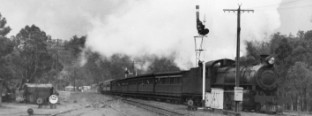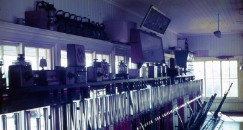Maylands
WAGR - Eastern Railway (E. R.) | |
1938 WAGR MAP Mileage = 3 | |
Next Down Station: | Next Up Station: |
Quick Facts |
|
Opened |
Closed |
1899 |
? |
Mechanical |
Electrical |
15 Levers |
Illuminated Diagram |
Fate: Destroyed by Fire |
|
The Maylands signal Cabin, opened on October 17th 1899. It was a timber, platform-level signal cabin, and although perhaps similar to Mount Lawley cabin in this regard, the levers faced away from the tracks to give the Signalman a better view of the line. The signal cabin was located on the Up platform at the Eastern end of the brick station building, which remains to this day. One wonders if the signal cabin would have escaped it's firery end had it been a brick structure instead of the weatherboard and corrugated iron so prevalent in Western Australian signal box design?
This photo recently to hand of the Maylands Cabin is by R. Taylor and showed the buildings in a fresh coat of paint. The cabin appears to have been extended at the front by building in under the eaves. One can only assume that this was to give better visibility of the line as the cabin was set back on the platform. The station building's elegant awning with its timberwork ends and valance, was typical of the early Eastern Railway 'standard' structures. The platform from which this photo was taken now remains - as an Island platform with the dual-gauge lines running either side. The brick section of this station is all that remains of the original station at Maylands.
Prior to being called Maylands, the station at this location was known as Falkirk between 1897 and 1899.
Home and Distant signals were provided on 19th April 1897, but these were for "shunting purposes only" and further instructions stated that "Under no consideration must the signals be lighted..." - Very different Rules than today's standards in signal illumination..!
Prior to 1897 Falkirk was known as 15 Mile Siding (measured from Fremantle) on the suburban section of the Eastern Railway.
The 1963 General Appendix to the Book of Rules and Working Time Table shows instructions for Maylands which virtually relegated it to Block Box status - only being opened as required for the shunting of the nearby Massey-Ferguson Austraila Pty. Ltd. siding (formerly Millars sawmill siding).
Over the years, and depending on just who was 'switched in', Maylands worked on the west side with Mount Lawley; Summer Street or East Perth (later named Claisebrook) - or on the eastern side, with Meltham (a Block Box); Bayswater; Ashfield (a Block Box); Bassendean; Guildford; East Guildford (a Block Box); West Midland (a Block Box); or Midland Box 'A' (and finally the Midland Panel in the last years of it's life).
Crossing the yard mid-way, the still busy Caledonian Avenue road crossing was once protected by gates worked by the Signalman - a far cry from today's automatic half-boom gates and flashing lights which are synchronised with the road traffic lights either side of the railway reserve. Gauge discrimination circuits were provided in 1969 as part of the conversion to dual-gauge of the line between Perth Terminal and Midland.
MayLands cabin had a 15 lever McKenzie & Holland No. 9 Patt. frame, most of the levers remaining in use until the signal cabin was rendered obsolete before the coming of electrification. In 1982, an electric switchlock (numbered 2BWL) controlled a trailing crossover between the 'Down' and 'Up' main lines, whilst yard access was controlled from the 'Up' Main via switchlock No. 2AWL.
At the time of taking this photo, Circa 1975, every lever was in use. Here at Maylands, No. 15 was the Automatic Control lever used for cutting 'in' or 'out'. The lever handles appear to be painted silver, and the rest of the levers have been recently re-painted, and yes you guessed it - soon after, the cabin was dispensed with - proving the myth! There was no Signalman here by then, the Stationmaster was working the cabin as required for moves into the tractor factory.
These days, Maylands is merely another stopping place on the dual-gauge "Midland Line" of the electrified suburban system, the Electrical Multiple Units now calling at either side of the former 'Down' platform - now an island platform.
The Maylands cabin seemed very tidy. The illuminated track diagram had somewhat of a 'framed picture'appearence about it. Unless the lamp holder's terminations were accessable through the wall, then servicing them might have been difficult. Note the Union Switch & Signal Co. approach lock timer mounted on a bracket to the side of the frame and lots of Siemens, General Electric (S.G.E.) shelf indicator lights!
NOTE: The Editor would be very grateful for any information regarding the exact closing date of Maylands signal cabin as the official records are devoid of this information.
The Maylands cabin met an ignominious end when it was destroyed by fire on the 28th of December 1981, the fact being published in the West Australian newspaper the next day.
Information researched and interpreted by Chris. J. E. French of SignallingWA
Additional information supplied by SIGWA member Justin Smith.
Photographs © by Chris. J. E. French; B. Courtney and R. Taylor courtesy of Rail Heritage WA Archives (T3821)
Buy this page or View your SignallingWA Shopping Cart
This page is copyright, and permission must be sought from SignallingWA before this page is used for any purpose other than personal education.
MAYLANDS Employees | ||
This list may not be complete and does not yet include employees who worked here without being appointed. Where an appointment date is unknown, the Weekly Notice (WN) date advising of the appointment or other official documentation, i.e. Certificate of Competency (CC) will be used. | ||
Name | Appointed | Position |
Is a name missing? Please submit any corrections / additions with suitable evidence using the e-mail form above. | ||


